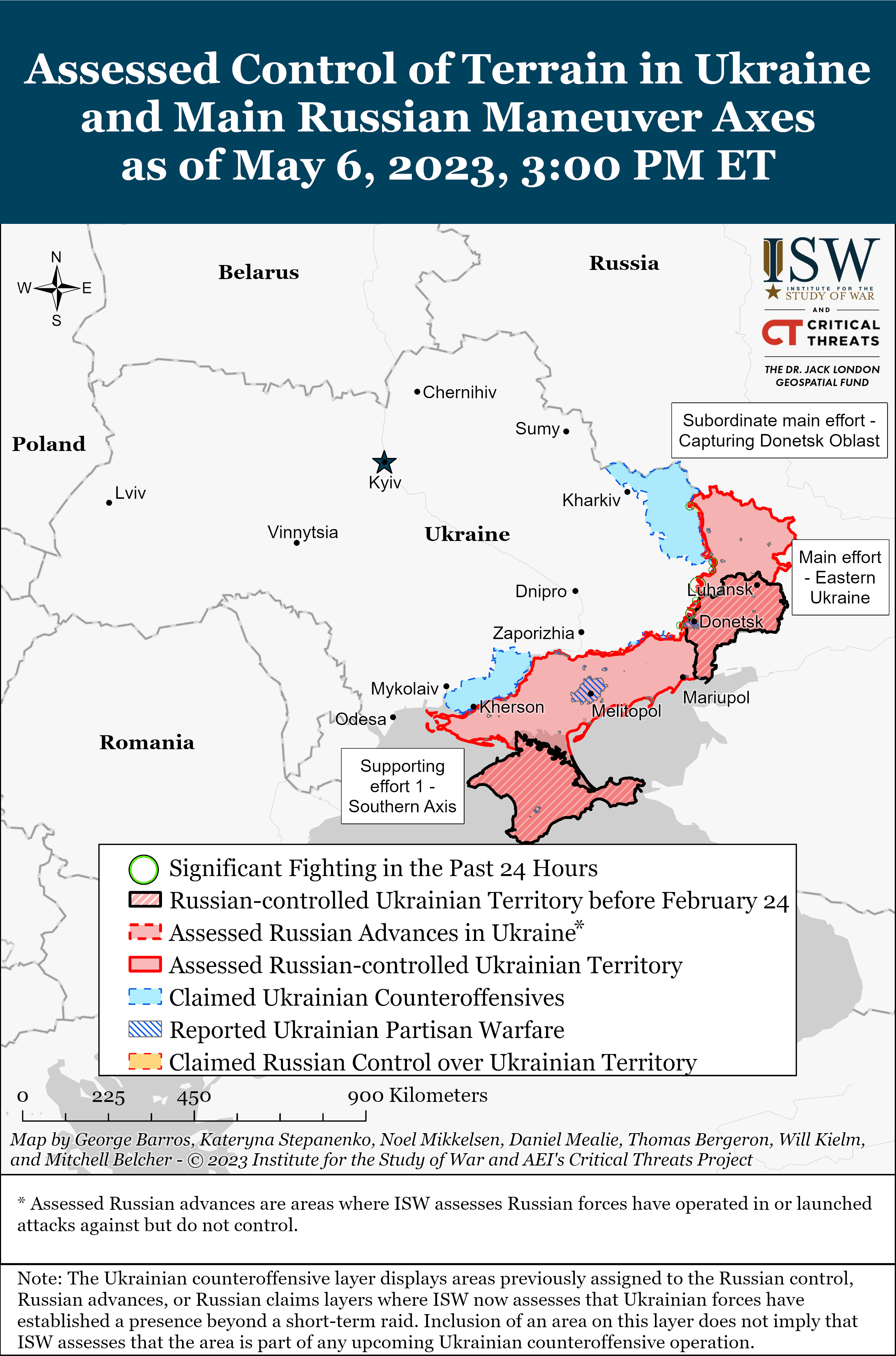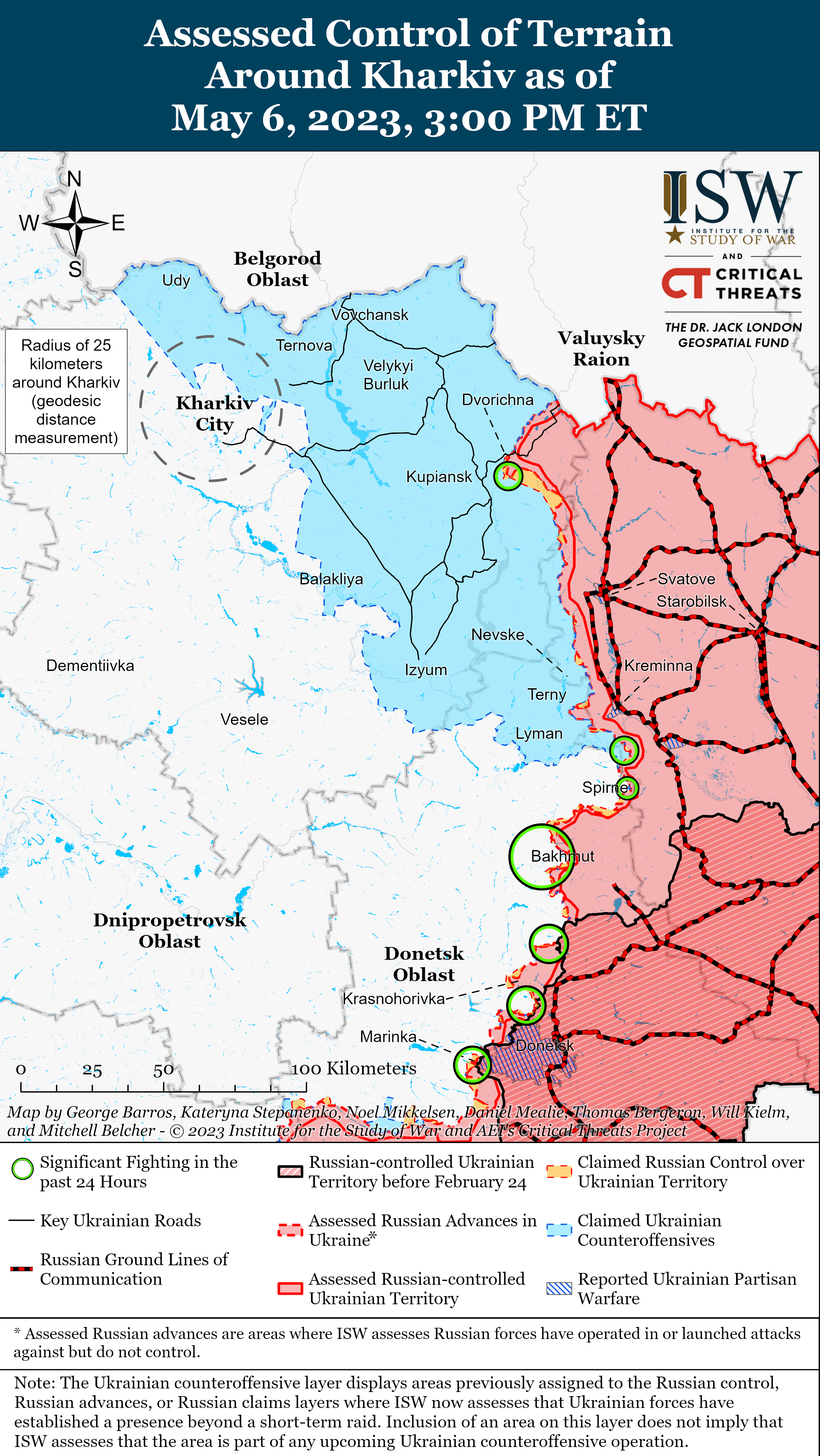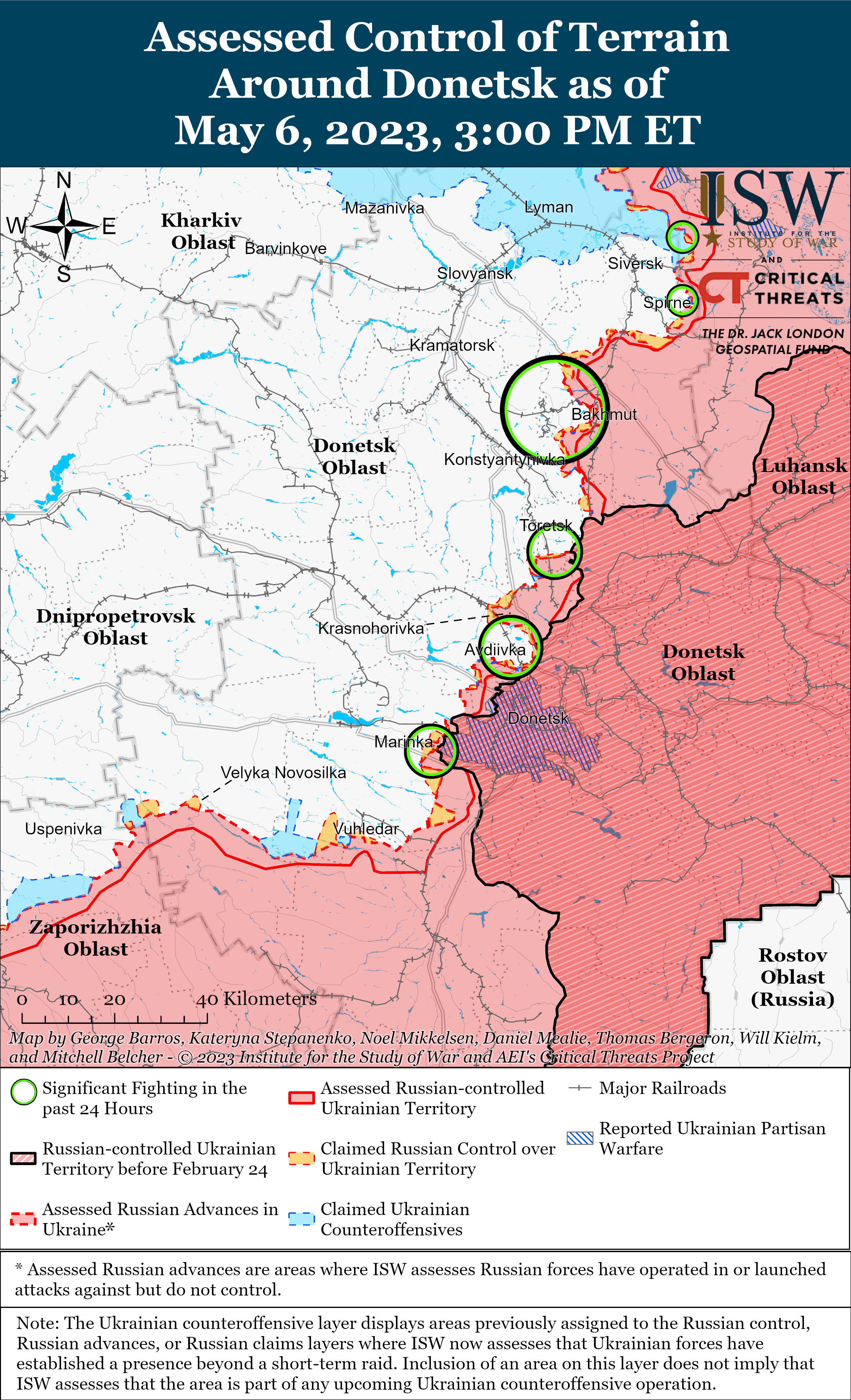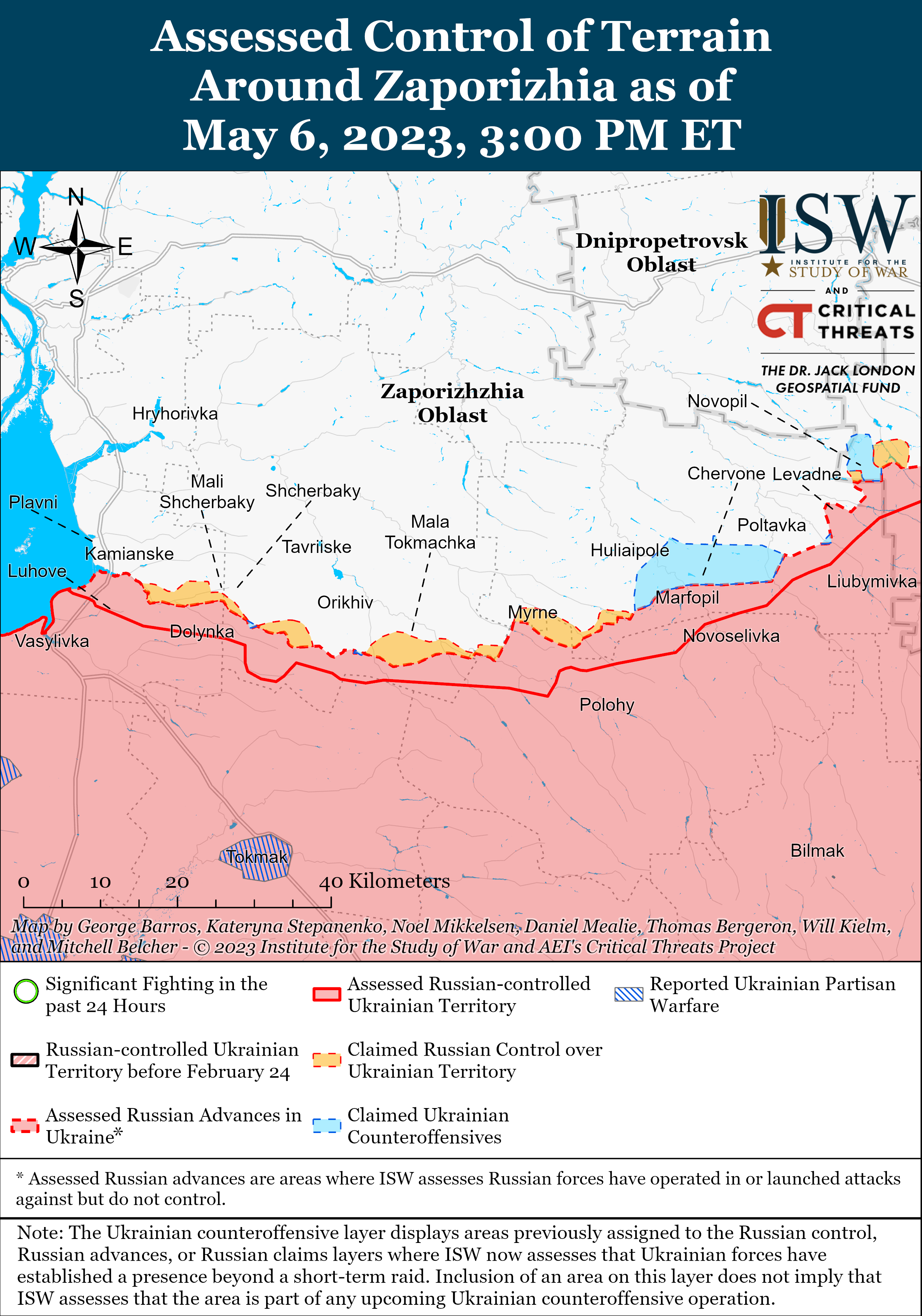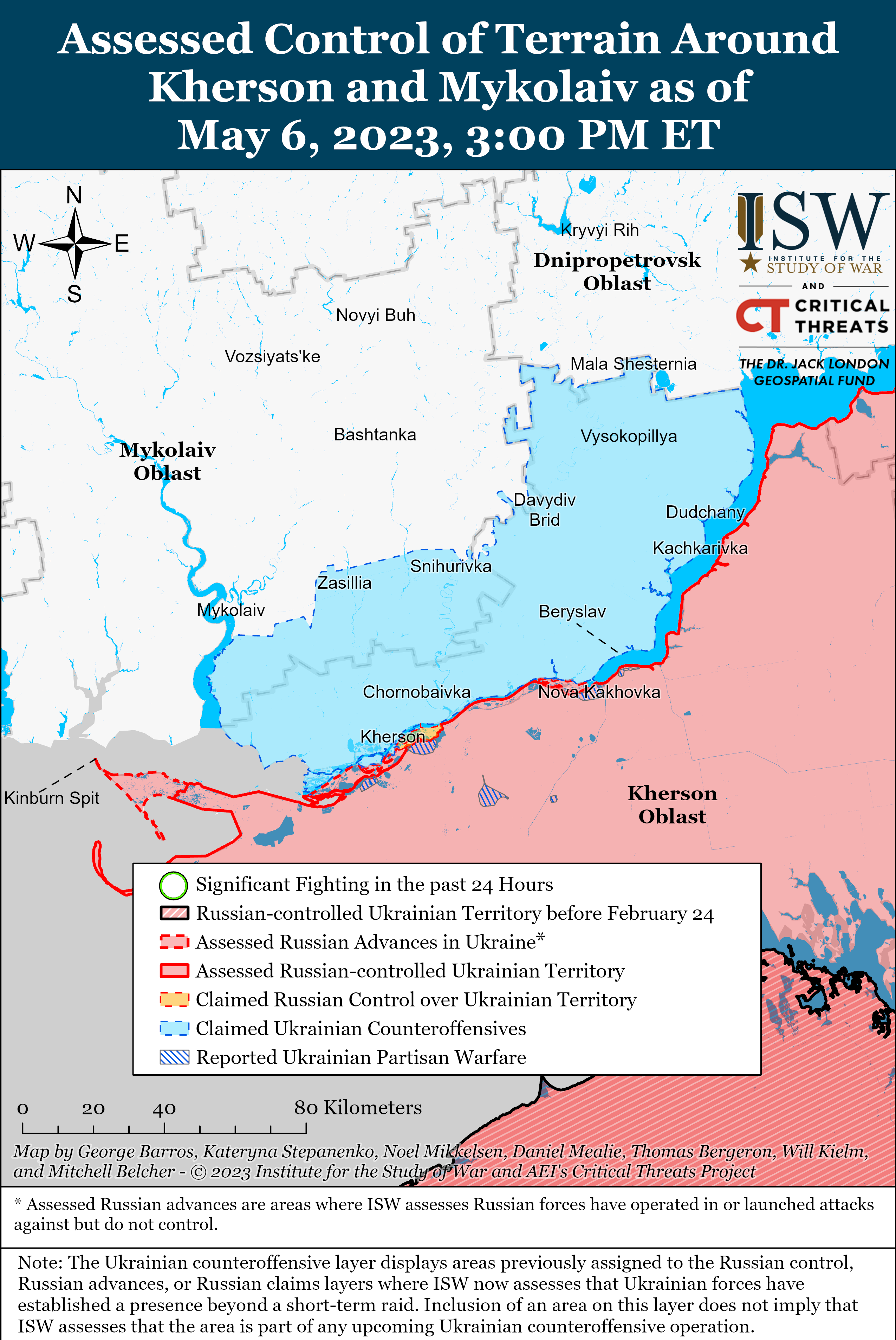Karolina Hird, Riley Bailey, Grace Mappes, and Mason Clark
May 6, 2023, 4:30pm ET
Click here to see ISW’s interactive map of the Russian invasion of Ukraine. This map is updated daily alongside the static maps present in this report.
Click here to access ISW’s archive of interactive time-lapse maps of the Russian invasion of Ukraine. These maps complement the static control-of-terrain map that ISW produces daily by showing a dynamic frontline. ISW will update this time-lapse map archive monthly.
Wagner Group financier Yevgeny Prigozhin and Chechen Republic Head Ramzan Kadyrov stated their intent on May 6 for Chechen “Akhmat” troops to replace Wagner Group forces in Bakhmut on May 10. Prigozhin published a letter to Russian Minister of Defense Sergei Shoigu on May 6 declaring that Wagner will hand over its positions to Akhmat units at exactly midnight on May 10, when Prigozhin claims Wagner will have entirely run out of combat potential.[1] Prigozhin expressed his confidence that Akhmat forces can capture the remaining 2.5 square kilometers of Bakhmut that remain under Ukrainian control.[2] Kadyrov responded to Prigozhin by stating he has addressed a letter to Russian President Vladimir Putin signaling his readiness to take Bakhmut and claimed that Chechen units are already working on a strategy with the Russian MoD for the Chechens to take over Wagner‘s positions.[3]
Prigozhin and Kadyrov likely aim to frame the Russian MoD and regular Russian troops as ineffective and set conditions to blame the MoD for any Russian setbacks in the Bakhmut area. Prigozhin’s decision to hand responsibility for Bakhmut over to the forces of a fellow silovik deliberately excludes the conventional Russian airborne (VDV) troops already operating on Wagner’s northern and southern flanks around Bakhmut, framing the battle of Bakhmut strictly as a Wagner – and now Akhmat – concern. This decision reflects Prigozhin’s ongoing distrust of the Russian military command, and postures himself as independent from the Russian military establishment and allows him to save face if Wagner forces cannot capture Bakhmut and avoiding a repeat of the capture of Soledar – where the Russian MoD took credit for what Prigozhin claimed was a Wagner success.[4] Kadyrov, in turn, could benefit from the positive reputational effect of entering such a high-profile operation with the backing of Prigozhin’s personal notoriety. Kadyrov recently met with several high-ranking Russian officials in Russia, likely to ameliorate his own reputation within Russian political circles.[5] The switch from Wagner to Akhmat troops may also set conditions to blame the Russian MoD for future failures down the line — if Akhmat forces experience similar difficulties to Wagner and are unable to completely capture Bakhmut, Prigozhin and Kadyrov may feasibly blame the MoD for failing to adequately support their efforts. Alternatively, if the Russian MoD prevents Akhmat forces from relieving Wagner (as it is unclear if Prigozhin and Kadyrov can execute this maneuver without any Russian MoD support as they claim), the two siloviki and their allies will likely brandish the hypothetical that if only the Russian MoD had supported the maneuver, Chechen forces would have captured Bakhmut quickly.
While the potential deployment of Akhmat troops to Bakhmut could increase Russian combat power to some degree, the claims made by Prigozhin and Kadyrov are greatly exaggerated. Akhmat forces have deployed throughout Ukraine, mostly in the Bilohorivka area in Luhansk Oblast and in scattered areas in the south, over the course of 2023 but have not been majorly committed to decisive offensive operations.[6] The Chechen forces that would deploy to Bakhmut are therefore likely substantially fresher and less degraded than Wagner forces which have remained on the front for months. However, Kadyrov’s suggestion that Akhmat will be able to rapidly advance in and occupy Bakhmut in “a matter of hours” is typical Kadyrov braggadocio and ignores the tactical situation on the ground in Bakhmut.[7] Additionally, Prigozhin’s suggestion that Wagner will lose its combat potential at exactly midnight on May 10 is a rhetorical point selected to avoid withdrawing before Victory Day on May 9 - fighting forces do not precipitously exhaust all their combat capabilities in one discrete instant.
The Russian MoD has yet to respond to Prigozhin and Kadyrov’s coordinated posturing about Bakhmut and may have been caught flatfooted by Prigozhin and Kadyrov’s statements. ISW assesses that the Russian military is likely reprioritizing logistics and sustainment processes to transition to defensive operations in most areas of the theater ahead of an expected Ukrainian counteroffensive, and Prigozhin’s focus on Bakhmut may be at odds with changing Russian MoD priorities.[8] Russian forces likely do not have reserves they could commit to Bakhmut should Wagner’s ability to sustain operations in the city completely collapse, as Prigozhin is claiming.[9] The Russian MoD continues to claim that Russian Airborne Forces (VDV) are defending the flanks around Bakhmut, and ISW has not observed VDV elements directly contributing to Wagner’s offensive within the city itself.[10] The Russian military likely intends for these VDV elements to stabilize the wider Bakhmut salient given Wagner’s increasingly degraded combat effectiveness in the area, and Russian forces are unlikely to commit these elements to a final phase of attritional fighting in Bakhmut ahead of expected Ukrainian counteroffensive operations.[11] The capture of the last remaining section of Bakhmut offers no wider operational benefits and would only provide limited informational benefits for the Kremlin. The MoD’s silence is likely reflective of a conscious decision to not offset Wagner’s degradation or placate Prigozhin’s expected anger, although the lack of response is allowing Prigozhin more maneuver space to shape the overall reaction to the de-prioritization of the Bakhmut offensive.
At least one individual with claimed but unconfirmed affiliation to the Ukrainian government attempted to assassinate Russian “A Just Russia” State Duma party co-leader and prominent nationalist voice Zakhar Prilepin on May 6. The attackers targeted Prelipin with an improvised explosive device (IED) on or near Prilepin’s car in Pionerskoye, Nizhny Novgorod Oblast, killing Prilepin’s driver and severely injuring Prilepin.[12] The Russian Investigative Committee announced it is investigating the attack as a terrorist attack and stated Russian security forces arrested Oleksandr Permyakov, who Russian state-affiliated media claimed conducted the attack on the orders of Ukrainian Special Services (SBU).[13] Russian news aggregator Channel 112 claimed that Russian authorities detained a second unspecified attacker in a nearby forest area, but Russian authorities have not corroborated this report.[14] Russian Ministry of Foreign Affairs (MFA) Spokesperson Maria Zakharova accused Ukraine and the West of orchestrating the attack, though Kremlin Spokesperson Dmitry Peskov stated that it is too early to know the attackers and orchestrators.[15] The Atesh Ukrainian-Tatar resistance movement claimed indirect responsibility for the attack, though Ukrainian and Russian officials have not corroborated this claim.[16] Wagner Group financier Yevgeny Prigozhin has reportedly fostered ties with ”A Just Russia” party leadership, though it is uncertain if the attack against Prilepin is related to Prigozhin.[17]
Many prominent Russian nationalist information space voices expressed anger at another attack against a prominent pro-war voice in Russia itself and connected the attack to the assassinations of Darya Dugina and Maxim Fomin (Vladlen Tartarsky).[18] Many milbloggers blamed Ukraine and Western states for orchestrating the attack and called on Russia to increase law enforcement measures.[19] Some milbloggers called on Russia to provide personal security for prominent milbloggers or to re-establish the Soviet-era SMERSH counterintelligence umbrella to combat enemy penetration attempts.[20]
CNN reported that Russian electronic warfare (EW) jamming has limited the effectiveness of Ukrainian HIMARS strikes in recent months.[21] CNN cited five US, UK, and Ukrainian sources as saying that US and Ukrainian forces have had to adapt workarounds to counter “evolving” Russian EW jamming efforts, and that Russian forces have subsequently developed countermeasures to those workarounds.[22] US officials stated that destroying Russian EW systems is a high priority in maintaining the battlefield effectiveness of HIMARS.[23] ISW is unable to confirm this report, but Russian forces retain at least some ability to adapt to battlefield conditions despite significant degradation.
Key Takeaways
- Wagner Group financier Yevgeny Prigozhin and Chechen Republic Head Ramzan Kadyrov stated their intent on May 6 for Chechen “Akhmat” troops to replace Wagner Group forces in Bakhmut on May 10.
- Prigozhin and Kadyrov likely aim to frame the Russian MoD and regular Russian troops as ineffective and set conditions to blame the MoD for any Russian setbacks in the Bakhmut area.
- While the potential deployment of Akhmat troops to Bakhmut could increase Russian combat power to some degree, the claims made by Prigozhin and Kadyrov are greatly exaggerated.
- The Russian MoD has yet to respond to Prigozhin and Kadyrov’s coordinated posturing about Bakhmut and may have been caught flatfooted by Prigozhin and Kadyrov’s statements.
- At least one individual with claimed but unconfirmed affiliation to the Ukrainian government attempted to assassinate Russian “A Just Russia” State Duma party co-leader and prominent nationalist voice Zakhar Prilepin on May 6.
- CNN reported that Russian electronic warfare (EW) jamming has limited the effectiveness of Ukrainian HIMARS strikes in recent months.
- Russian forces continued limited offensive operations northeast of Kupyansk and in the Kreminna area.
- Russian forces continued to make marginal gains within Bakhmut and Ukrainian forces likely conducted a successful limited counterattack southwest of Avdiivka.
- Russian occupation officials claimed that Ukrainian forces targeted Crimea with Hrim-2 short-range ballistic missiles.
- Ukrainian sources reported that Russian authorities are continuing various measures to forcibly mobilize residents of occupied areas of Ukraine.
- Russian occupation officials continue to plan for mass forced evacuations in Zaporizhia Oblast.
We do not report in detail on Russian war crimes because these activities are well-covered in Western media and do not directly affect the military operations we are assessing and forecasting. We will continue to evaluate and report on the effects of these criminal activities on the Ukrainian military and the Ukrainian population and specifically on combat in Ukrainian urban areas. We utterly condemn these Russian violations of the laws of armed conflict, Geneva Conventions, and humanity even though we do not describe them in these reports.
- Russian Main Effort – Eastern Ukraine (comprised of two subordinate main efforts)
- Russian Subordinate Main Effort #1 – Capture the remainder of Luhansk Oblast and push westward into eastern Kharkiv Oblast and encircle northern Donetsk Oblast
- Russian Subordinate Main Effort #2 – Capture the entirety of Donetsk Oblast
- Russian Supporting Effort – Southern Axis
- Russian Mobilization and Force Generation Efforts
- Activities in Russian-occupied areas
Russian Main Effort – Eastern Ukraine
Russian Subordinate Main Effort #1 – Luhansk Oblast (Russian objective: Capture the remainder of Luhansk Oblast and push westward into eastern Kharkiv Oblast and northern Donetsk Oblast)
Russian forces continued limited offensive operations northeast of Kupyansk and in the Kreminna area on May 6. The Ukrainian General Staff reported that Russian forces conducted unsuccessful offensive operations near Synkivka, Kharkiv Oblast (8km northeast of Kupyansk); Bilohorivka, Luhansk Oblast (12km south of Kreminna); and Spirne, Donetsk Oblast (25km south of Kreminna).[24] Russian Western Grouping of Forces Spokesperson Sergey Zybinsky claimed that Russian forces destroyed four Ukrainian sabotage and reconnaissance groups near Novomlynsk, Kharkiv Oblast (20km northeast of Kupyansk) and Novoselivske, Luhansk Oblast (14km northwest of Svatove).[25] The Russian Ministry of Defense (MoD) claimed that Ukrainian forces are counterattacking in the direction of Lysychansk (20km southeast of Kreminna), although ISW has not observed visual confirmation of recent Ukrainian counterattacks in this area of the front.[26]
Russian sources claim that Ukrainian forces struck Russian rear areas in Rubizhne, Luhansk Oblast (8km east of Kreminna) with four HIMARS rockets on May 6.[27]
Russian Subordinate Main Effort #2 – Donetsk Oblast (Russian Objective: Capture the entirety of Donetsk Oblast, the claimed territory of Russia’s proxies in Donbas)
Russian forces continued to make marginal gains within Bakhmut as of May 6. Geolocated footage published on May 6 indicates that Russian forces likely advanced further in western Bakhmut.[28] Wagner Group financier Yevgeny Prigozhin claimed that Ukrainian forces currently control 2.5 square km of Bakhmut.[29] Russian milbloggers claimed that Wagner fighters continued assaults in western Bakhmut and that Ukrainian forces are counterattacking near Khromove (immediately west of Bakhmut).[30] The Ukrainian General Staff reported that Russian forces conducted unsuccessful offensive operations near Bohdanivka (6km northwest of Bakhmut), Hryhorivka (9km northwest of Bakhmut), Ivanivske (6km west of Bakhmut), and Niu York (30km southwest of Bakhmut).[31]
Russian forces continued limited offensive operations along the Avdiivka-Donetsk front on May 6. The Ukrainian General Staff claimed that Russian forces conducted unsuccessful offensive operations near Avdiivka and Marinka (27km southwest of Avdiivka).[32] Russian sources claimed that Russian forces conducted positional assaults near the H-20 (Donetsk City-Kostyantynivka) highway west of Novobakhmutivka (13km northeast of Avdiivka) as of May 5.[33] A Russian milblogger claimed that Russian forces conducted an unsuccessful assault near Pervomaiske (11km southwest of Avdiivka).[34] The milblogger also acknowledged that the tempo of Russian offensive operations along the Avdivika-Donetsk front has declined.[35] ISW has previously assessed that Russian forces have largely decreased the tempo of offensive operations throughout the theater, including along the Avdiivka-Donetsk front, in preparation for transitioning to defensive operations ahead of an expected Ukrainian counteroffensive.[36]
Ukrainian forces likely conducted a successful limited counterattack southwest of Avdiivka. Geolocated footage published on April 30 indicates that Ukrainian forces likely conducted a limited counterattack north of Vodyane (7km southwest of Avdiivka) and made marginal gains in the area.[37] The Russian MoD claimed on May 6 that Ukrainian forces are counterattacking in the Avdiivka area as well as around Bakhmut.[38] ISW has previously assessed that reports of Ukrainian counterattacks throughout Donetsk Oblast appear to be a part of an ongoing pattern of localized and limited Ukrainian counterattacks.[39]
Russian forces did not conduct any confirmed ground attacks in western Donetsk Oblast on May 6.[40] Russian Eastern Grouping of Forces Spokesperson Alexander Gordeev claimed that Russian forces repelled a Ukrainian reconnaissance-in-force operation in western Donetsk Oblast on May 5.[41]
Russian Supporting Effort – Southern Axis (Russian objective: Maintain frontline positions and secure rear areas against Ukrainian strikes)
Russian occupation officials claimed that Ukrainian forces targeted Crimea with Hrim-2 short-range ballistic missiles on May 6. Crimean Occupation Head Sergey Aksyonov and Advisor Oleg Kryuchov claimed that Russian forces shot down two Hrim-2 missiles over Privetne, Crimea (10km northwest of Staryi Krim), causing no casualties or damage.[42] Neither official specified the strike’s target. Russian sources amplified footage allegedly of the missile remnants in a large field.[43] Russian occupation authorities and milbloggers previously claimed that Ukrainian forces targeted Feodosia, Crimea and the Kerch Strait Bridge with Hrim-2 missiles on April 8 and April 22, respectively.[44]
Russian occupation officials expressed continued concern over a prospective Ukrainian counteroffensive in Zaporizhia Oblast. Zaporizhia Oblast occupation deputy Vladimir Rogov claimed that Ukrainian forces will be able to launch a counteroffensive in Zaporizhia Oblast in the coming days and claimed that Ukrainian forces have intensified strikes against frontline and rear areas.[45] Rogov noted that weather conditions in Zaporizhia Oblast have improved and that the ground in Zaporizhia Oblast has dried out.[46] Weather forecasts for Tokmak, Hulyaipole, and Vasylivka Zaporizhia Oblast predict that there is a 50 percent chance of rain on two of the coming 14 days.[47] Russian state nuclear energy agency Rosatom officials denied rumors that it had instructed Zaporizhzhia Nuclear Power Plant (ZNPP) personnel to evacuate from occupied Enerhodar and claimed there is no reason for concern.[48] Zaporizhia Oblast Occupation Head Yevgeny Balitsky announced that Enerhodar is one of 18 cities and settlements in the oblast currently undergoing partial evacuations, as ISW has previously reported.[49]
Russian occupation authorities temporarily suspended transport across the Kerch Strait Bridge on May 6. Occupation officials claimed that authorities closed the bridge due to unspecified technical reasons and that traffic has since resumed.[50] Russian authorities announced the completed restoration of the Kerch Strait rail bridge and plans for over 80 inspection points for road traffic across the bridge on April 26.[51]
Russian forces continued heavy fire against areas west of Hulyaipole and in Kherson and Dnipropetrovsk oblasts on May 6.[52] Dnipropetrovsk Oblast Head Serhii Lysak reported that Ukrainian forces shot down four Russian UAVs targeting Kryvyi Rih, Dnipropetrovsk Oblast.[53]
Russian Mobilization and Force Generation Efforts (Russian objective: Expand combat power without conducting general mobilization)
Ukrainian sources reported on May 6 that Russian authorities are continuing various measures to forcibly mobilize residents of occupied areas of Ukraine. The Ukrainian Resistance Center stated that Russian authorities seek to amend the law on “the procedure for evacuating the population, material, and cultural values to safe areas” in order to filter male residents of occupied areas into separate camps when evacuating populations from certain areas.[54] The Resistance Center noted that these men will then be handed over to military commissars for mobilization and emphasized that this may also happen in Russian territory in order to compensate for personnel losses.[55] Head of the Ukrainian Reservist Council Ivan Tymochko relatedly stated on May 6 that Russian authorities are using mass passportization efforts in occupied areas to mobilize residents because residents are subject to mobilization upon receipt of Russian citizenship.[56]
Russian authorities continue efforts to digitize mobilization processes. The Russian Ministry of Digital Development submitted a proposal to create a unified digital register of military records, which will be phased into use in various stages up until 2025.[57] The Russian Ministry of Digital Development plans to first approve the methodological, organization, and technical conditions of the register, gradually implement its use throughout 2024, and enter it into full use with the Russian Ministry of Defense (MoD) on January 1, 2025.
Activities in Russian-occupied areas (Russian objective: Consolidate administrative control of annexed areas; forcibly integrate Ukrainian civilians into Russian sociocultural, economic, military, and governance systems)
Russian occupation officials continue to plan for mass forced evacuations in Zaporizhia Oblast. Zaporizhia Oblast occupation head Yevgeny Balitsky held a working meeting on May 5 to discuss and facilitate the “temporary relocation” of residents away from frontline areas of Zaporizhia Oblast due to shelling and combat clashes.[58] Zaporizhia Oblast occupation deputy Vladimir Rogov noted that the occupation administration, Ministry of Emergency Situations, and law enforcement elements are removing residents and reported that the occupation administration is receiving evacuated residents in Berdyansk.[59] Rogov stated that individuals will have their documents checked, which suggests that the occupation administration may use this as an opportunity to further passportize residents when checking their documents at evacuation points.[60] Rogov also indicated that parents of evacuated children may ”choose” to send their children to rest and rehabilitation camps.[61] Russian occupation organs will likely use the massive evacuations to support various lines of effort meant at strengthening social, bureaucratic, and administrative control of occupied areas of Zaporizhia Oblast.
Significant activity in Belarus (ISW assesses that a Russian or Belarusian attack into northern Ukraine in early 2023 is extraordinarily unlikely and has thus restructured this section of the update. It will no longer include counter-indicators for such an offensive.)
ISW will continue to report daily observed Russian and Belarusian military activity in Belarus, but these are not indicators that Russian and Belarusian forces are preparing for an imminent attack on Ukraine from Belarus. ISW will revise this text and its assessment if it observes any unambiguous indicators that Russia or Belarus is preparing to attack northern Ukraine.
The Belarusian Ministry of Defense stated on May 6 that unspecified Belarusian Special Forces brigades, maneuver elements, and missile forces units conducted exercises as part of the ongoing combat readiness check.[62]
Note: ISW does not receive any classified material from any source, uses only publicly available information, and draws extensively on Russian, Ukrainian, and Western reporting and social media as well as commercially available satellite imagery and other geospatial data as the basis for these reports. References to all sources used are provided in the endnotes of each update.
[4] https://isw.pub/UkrWar012223; https://isw.pub/UkrWar011823; https://isw.pub/UkrWar011623; https://isw.pub/UkrWar011323
[5]https://t.me/RKadyrov_95/3579; https://t.me/RKadyrov_95/3578; https://t.me/RKadyrov_95/3576; https://t.me/RKadyrov_95/3575
[9] https://www.understandingwar.org/backgrounder/russian-offensive-campaign-assessment-april-23-2023
[10] https://t.me/mod_russia/26223 ; https://www.understandingwar.org/backgrounder/russian-offensive-campaign-assessment-april-23-2023
[12] https://www.fontanka dot ru/2023/05/06/72284105/; https://t.me/rbc_news/73556; https://t.me/idelrealii/27137; https://www.fontanka dot ru/2023/05/06/72284105/; https://t.me/rbc_news/73556 ; https://twitter.com/bayraktar_1love/status/1654781626063126528 ; https://t.me/idelrealii/27137; https://t.me/severrealii/16552; https://t.me/severrealii/16552; https://t.me/vrogov/9246 ; https://t.me/vrogov/9250 ; https://t.me/vrogov/9251
[13] https://t.me/sledcom_press/6653; https://ria dot ru/20230506/podryv-1870159587.html; https://ria dot ru/20230506/pokushenie-1870222198.html
[15] https://t.me/rian_ru/201898; https://www.vedomosti dot ru/society/articles/2023/05/06/974073-nizhnem-novgorode
[18] https://t.me/rybar/46673; https://t.me/NeoficialniyBeZsonoV/25057; https://t.me/vysokygovorit/11495; https://t.me/strelkovii/4764; https://t.me/notes_veterans/9322; https://t.me/sashakots/39658; https://t.me/boris_rozhin/84900 ; https://t.me/boris_rozhin/84901 ; https://t.me/boris_rozhin/84906
[19] https://t.me/Aksenov82/2467; https://t.me/razvozhaev/2716; https://t.me/pushilindenis/3400; https://t.me/SolovievLive/176349; https://t.me/basurin_e/1308; https://t.me/basurin_e/1309; https://t.me/wargonzo/12350; https://t.me/voenkorKotenok/47347; https://t.me/sashakots/39658
[20] https://t.me/SergeyKolyasnikov/48354; https://t.me/NeoficialniyBeZsonoV/25064; https://t.me/rybar/46673; https://t.me/NeoficialniyBeZsonoV/25057; https://t.me/vysokygovorit/11495; https://t.me/notes_veterans/9325; https://t.me/notes_veterans/9329; https://t.me/voenkorKotenok/47347; https://t.me/sashakots/39658
[24] https://www.facebook.com/GeneralStaff.ua/posts/pfbid02hRzhey1h6MSPRfcf5xgzjA5hqrTCsZtc2osw788NiHnJMKAQLtsRSZkPQWnriP42l
[27] https://t.me/sons_fatherland/10478; https://t.me/miroshnik_r/11290; https://t.me/LPR_JCCC/8249;
[28] https://twitter.com/blinzka/status/1654818859839283202; https://twitter.com/markito0171/status/1654810224815923200; https://twitter.com/markito0171/status/1654810662843953153
[31] https://www.facebook.com/GeneralStaff.ua/posts/pfbid031HdnnsAUpaqZ9P2PJtDDix9wqS1VtEhRFXUZPUafADCQUtB8cJ7opdkLtiA8AYzZl ; https://www.facebook.com/GeneralStaff.ua/posts/pfbid02hRzhey1h6MSPRfcf5xgzjA5hqrTCsZtc2osw788NiHnJMKAQLtsRSZkPQWnriP42l
[32] https://www.facebook.com/GeneralStaff.ua/posts/pfbid031HdnnsAUpaqZ9P2PJtDDix9wqS1VtEhRFXUZPUafADCQUtB8cJ7opdkLtiA8AYzZl ; https://www.facebook.com/GeneralStaff.ua/posts/pfbid02hRzhey1h6MSPRfcf5xgzjA5hqrTCsZtc2osw788NiHnJMKAQLtsRSZkPQWnriP42l ;
[37] https://twitter.com/franfran2424/status/1654757762000211968; https://twitter.com/neonhandrail/status/1654574475525111808; https://twitter.com/franfran2424/status/1654560594635153409; https://twitter.com/franfran2424/status/1654758792771321861; https://t.me/nm_dnr/10285; https://t.me/operator13zov/9712
[40] https://www.facebook.com/GeneralStaff.ua/posts/pfbid031HdnnsAUpaqZ9P2PJtDDix9wqS1VtEhRFXUZPUafADCQUtB8cJ7opdkLtiA8AYzZl ; https://www.facebook.com/GeneralStaff.ua/posts/pfbid02hRzhey1h6MSPRfcf5x...
[43] https://t.me/readovkanews/58298 ; https://t.me/voenkorKotenok/47357; https://t.me/Tsaplienko/31252;
[44] https://www.understandingwar.org/sites/default/files/Russian%20Offensive%20Campaign%20Assessment%20April%208%202023.pdf; https://www.understandingwar.org/sites/default/files/Russian%20Offensive...
[45] https://t.me/vrogov/9220; https://t.me/vrogov/9220; https://t.me/vrogov/9252; https://t.me/vrogov/9253;
[47] https://weather.com/weather/tenday/l/5cbe3ca390e333533ac12f6fbc0494be936a093a63861bbf7c96514c8bf6c350#detailIndex5; https://weather.com/weather/tenday/l/Zaporizhzhia+Oblast+Zaporizhzhia+Oblast+Ukraine?canonicalCityId=289a89ec607e71beac70f0b2d6a5d0f6fea2730a6dfac3d0f7e297e96156cdae; https://weather.com/weather/tenday/l/99a923459c5b472c2788de05997b7adb576...
[49] https://t.me/readovkanews/58209; https://t.me/notes_veterans/9303; https://t.me/milinfolive/100217; https://t.me/bazabazon/17409; https://t.me/astrapress/26231; https://www.understandingwar.org/backgrounder/russian-offensive-campaign...
[50] https://www.interfax dot ru/russia/900384; https://www.interfax dot ru/russia/900385
[52] https://t.me/dnipropetrovskaODA/4484; https://t.me/zoda_gov_ua/18599; https://t.me/VGA_Kherson/9178; https://www.facebook.com/OperationalCommandSouth/posts/pfbid0g4Gq7UbUeyk... https://suspilne dot media/467786-na-hersonsini-sili-oboroni-znisili-polovij-punkt-boepostacanna-ta-16-odinic-ozbroenna-i-tehniki-vijsk-rf/; https://www.facebook.com/GeneralStaff.ua/posts/pfbid031HdnnsAUpaqZ9P2PJtDDix9wqS1VtEhRFXUZPUafADCQUtB8cJ7opdkLtiA8AYzZl; https://www.facebook.com/GeneralStaff.ua/posts/pfbid02hRzhey1h6MSPRfcf5x...
[54] https://sprotyv.mod dot gov.ua/prykryvayuchys-evakuatsiyeyu-okupanty-hochut-mobilizovuvaty-meshkantsiv-tot/
[55] https://sprotyv.mod dot gov.ua/prykryvayuchys-evakuatsiyeyu-okupanty-hochut-mobilizovuvaty-meshkantsiv-tot/
[57] https://regulation.gov dot ru/projects#npa=138094 https://t.me/mobilizationnews/11745; https://t.me/mobilizationnews/11749; https://t.me/severrealii/16541

